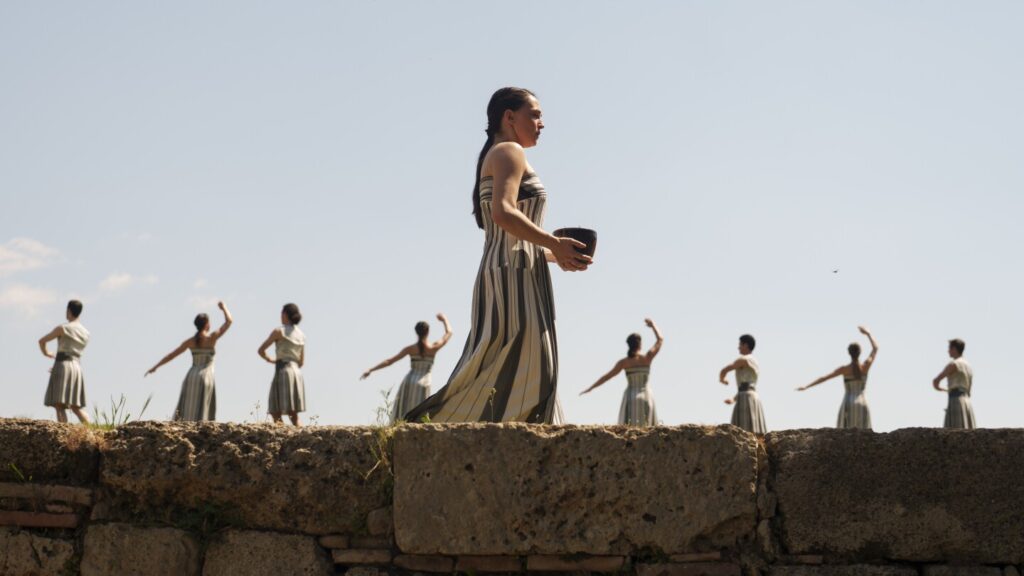ANCIENT OLYMPIA, Greece (AP) — No one knows what ancient Greek music was like or how dancers once moved.
Every two years, a new interpretation of an ancient performance captivates audiences around the world. It will be held in southern Greece, a place still considered sacred by many and the birthplace of the Olympic Games.
Forty-eight performers, chosen in part for their resemblance to ancient youths seen in statues and other extant works of art, will take part in the Paris Olympic flame-lighting ceremony on Tuesday.
Details of the 30-minute performance will be fine-tuned and kept secret until Monday's public rehearsal.
The Associated Press had rare access to rehearsals held over the weekend, mostly at the Olympic Indoor Velodrome in Athens.
An all-volunteer Olympic cast poses from ancient vases as athletes race around the banked cycling oval. The sequence is repeated over and over again under the direction of highly focused principal choreographer Artemis Ignatio.
“In ancient times there was no Olympic torch ceremony,” Ignatiou said during a recent practice.
“My inspiration comes from paintings on temple pediments and vases, because nothing has been preserved from antiquity, there is no movement, there is no dance,” she said. “Basically, what we're doing is combining these images. Everything in between is coming from us.”
A ceremony is held at Olympia every two years to coincide with the Winter and Summer Games, where sunlight is focused inside a parabolic mirror to create the Olympic torch and begin the torch relay to the host city.
First held at the 1936 Berlin Olympics, the ceremony features women dressed as priestesses. The group is led by an actress who plays the role of the high priest, and in the moments before the torch is lit, she makes a dramatic appeal to the ancient sun god Apollo for help.
Over the decades, new elements have been gradually added, including new colors in music, choreography, and costumes, male performers known as kouroi, and subtle styles that reflect the culture of the Olympic host country.
With increased complexity comes controversy, which is inevitably amplified by social media. This year's criticism focused on the dresses and tunics worn by the performers, which are styled to resemble ancient Greek columns. Troubleshooters have criticized it as a rude departure from the ceremony's customary elegance.
Organizers hope this outfit will create a more positive impression when seen at the ruins of ancient Olympia.
Counting through the sequences, Ignatius taps his phone to control the music as he watches male dancers working on a stop-motion-like routine on a velodrome and slides past them like a slowly unraveling spring. track the women passing by.
Ignatiou has been involved in this ceremony for 36 years as a priestess, high priest, assistant, and since 2008, head choreographer. She takes criticism calmly.
She still gets moved to tears when she describes the lighting of the torch, but she chooses to follow the dancers who practiced for five months as they described their experiences.
Most of the performers are in their early 20s, drawn from dance and theater academies, and aim to maintain an athletic appearance and classic Greek aesthetic, with their hair pulled back in a neat double layer. These are women who knit.
Christiana Katsinplaki, a 23-year-old drama school student who is attending Olympia for the first time, said she wanted to repay the kindness she received from her senior performers.
“When I close my eyes before going to bed, I go through the entire choreography to make sure I remember all the steps and that they're in the correct order. So I go through it,” she said. . “So that the next time you come to rehearsal, everything will go well and no one will be tired.”
The ceremony will be held with sparse music, and routine final touches will be made at Olympia to address the venue's pockmarked and uneven ground.
Dancers talk about the joys of group messaging, clever pranks on newcomers and four-hour bus rides to ancient ruins in southern Greece, but they also talk about the importance of the moment and the charm of the past. I also talk about .
“I'm in awe that we're going there and that I'm going to be a part of this whole team,” said 23-year-old performer Kalia Voydaski. “I'm going to recreate this whole experience of watching it on TV when I was little. I say, 'Ah!' How great would it be if I could do this someday?” ” And I did it. ”
The lighting ceremony will begin at 8:30 a.m. Japan time on Tuesday. The torch handover ceremony to the Paris 2024 Organizing Committee will be held separately in Athens on April 26.
___
Gatopoulos reported from Athens.
___
Associated Press coverage of the Paris Olympics: https://apnews.com/hub/2024-Paris-Olympic-Games

